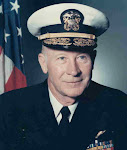
We had formed and trained at Quonset Point, Rhode Island--flew our planes cross country to Santa Rosa, California, and after some delay, embarked as passengers aboard USS CABOT to Hawaii. More training and delay but hopeful, as the Navy's first SPARE AIR GROUP, for a carrier to adopt us and give us a platform from which we could carry the fight to the enemy.
On 3 March 1944 at Pearl Harbor, Admiral Halsey assigned us to the newly arrived USS HORNET and on the 4th we were headed west to MAJURO, Marshall Islands. On arrival we were assigned to TASK FORCE 58 and became the Flagship for Rear Admiral “Jocko” Clark (58.1).
March 20th all squadron and air group commanders, were summoned to the Flagship of Admiral Mitscher for briefing and planning for our first strike. The Admiral said that Palau was second only to TRUK in its importance as a fleet anchorage for the Japanese. If we could bottle up or deprive their fleet elements the use of that harbor it would greatly enhance an operation planned later for Hollandia, New Guinea. His Operations Officer, Cdr. Gus Widhelm, an old friend, proceeded to brief the Torpedo Squadron Commanders on a few of the details we needed to put together our attack plan for laying the mines (MK 52 2000 Lb. parachute type).
This was to be the first aerial mine laying job by any element of the U.S. Navy. Then came some very important specifics:
1. The mines had to be released at no higher than 200 feet--so chute would open.
2. The speed of the aircraft should be at exactly 120 knots, straight and level -- no jinking.
3. The narrow channels we were mining had hills some 400 feet high on both sides and were probably heavily armed!
4. In order to cover all channels we would probably have to make three or four trips!
- 1 -
About this time I asked Gus, who was nervously waving a cigar as he talked, if he had another cigar. He produced one and the squadron commander on my left asked if he had another. We all alternately smoked and chewed those cigars through the remainder of the briefing. On return to the HORNET I decided I would put off briefing my pilots on the details for several days because the loss of sleep can be dangerous for someone flying a torpedo plane. Anyway we had nine or ten days until launch.
Proceeding towards Palau, on the night of March 29, our night fighter Combat Air Patrol intercepted and splashed a Japanese BETTY (twin engine bomber capable of carrying torpedoes). Since the presence of our Task Group had been discovered, it was decided we would have a pre-dawn launch.
There had been much discussion with the Air Officer regarding the spotting of my plane on the flight deck because I was to be first off and no one was quite sure how much deck was needed to get airborne with a 2000 lb. mine. Since the deck was fully spotted there was no appeal. To bed and up for the pre-dawn launch.
As we manned the planes in the pre-dawn darkness, I told my radioman, Adair, who was also the tunnel gunner to train the tunnel gun straight down and if he felt it striking the top of a wave to let me know. (Only a short time before, we had installed a radio altimeter which was supposed to give a much more accurate reading than our barometric altimeter, but complete confidence was lacking). As we took off into the blackness the radio altimeter, set for flight deck height, went immediately from yellow to red and in seconds Adair reported, "Skipper, 'the gun is bouncing!" Wheels were up and flaps bleeding slowly as I watched the radio altimeter go from red to yellow to green.
The rendezvous of our torpedo planes was accomplished with minor strain, but the accompanying fighters left something to be desired. As we approached Palau the sun was rising behind us -- a beautiful day with billowing clouds all around. Additional color was added to the scene as anti-aircraft bursts appeared as colored
- 2 -
clouds all around. we pushed over and headed for the various labyrinthine shipping lane channels. As we slowed to 120 knots and leveled off at 200 feet, you realized that the anti-aircraft guns were shooting down on you and you felt like a duck on the opening day of the hunting season!
Those mines were laid and channels closed. (On following flights the mine laying aircraft were given another 100 feet of flight deck for take-off).
Torpedo Two pilots were Lt. Cdr, J. D. Amold (Squadron Commander), Lt. Joe Moore, Lts. (jg) Kenny Glass, Troy Porterfield, Moose Langford, Ken Nelson, Clint Branham, K. G. Sull!van, Scotty Scammell, Ens. Bernard and Ens. Richards. (We lost Ens. Bereolos on the takeoff).
- 3 –
This memo was hand typed by Admiral Arnold and OCR’d for this posting.








.jpg)


